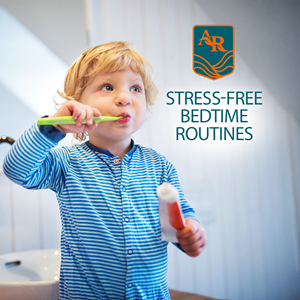
Daylight savings time has just passed around yet again. This is always a challenging time for people of all ages to adjust their sleep schedule, but it can be particularly challenging for children. The increased hour of sunlight will only continue to grow as we inch closer to the long, sunny days of summertime. Establishing a stress-free bedtime routine can help children stay on track to getting enough restful hours of restorative sleep. The American Academy of Sleep Medicine recommends the following:
- Infants (up to 11 months): 14 to 15 hours
- Toddlers: 12 to 14 hours
- Preschoolers: 11 to 13 hours
- School-age children: 10 to 11 hours
Practicing proper sleep hygiene can help children enter the various stages of sleep that are necessary to allow their brains and bodies restore themselves for another day of exploration and learning. Not only that, but getting proper amounts of sleep also helps to keep the immune system strong to fight off illnesses. A few simple changes can help bedtime become less of a struggle and more of a cherished tradition that your child will look forward to.
Refrain from using any screens for at least 30 minutes prior to bedtime.
Screens have a powerful effect on the brain. Their interactive nature psychologically engages the user and the blue light emitted from the device delays the body’s natural release of melatonin. Instead of allowing your child to relax with a screen, do a quiet activity together instead like reading a book, doing a puzzle, or cleaning up toys.
Give your child a warm bath.
Whether your child is old enough to bathe themselves or still requires your assistance, a warm bath or shower can do a lot of good. The warmth of the water helps to relax muscles and release tension and stress. It also helps to wash off any allergens that may have been collected in their hair or on their body during the day.
Change into pajamas.
Rather than letting your child go to sleep in the clothes they were wearing earlier in the day, make it a habit to change into pajamas each night. This makes a clear distinction between wake time and sleep time.
Don’t forget tooth brushing.
Creating lasting grooming and hygiene habits is important to physical and mental health. Have your child brush and floss their teeth each night before bed. If this is something they aren’t very fond of, you may try letting them choose a toothbrush on their own. Fun characters and even interactive toothbrushes can help make dental care more fun.
Keep a small cup of water by the bed.
Every parent has fallen into the, “I’m thirsty” trap. Bringing a small cup of water to their bedside will help put an end to this favorite childhood ruse to delay bedtime. Just enough for a couple sips will do the trick – any more and you’ll be giving in to a bathroom trip.
Make the room dim or dark.
Dim lighting and darkness trigger the body’s release of melatonin – a sleep-inducing hormone. If your child is afraid of the dark, a small night light can help ease their fears while still maintaining adequate darkness. Room-darkening curtains are also a good idea if your child’s bedtime begins while the sun is still out.
Talk quietly if needed.
Sometimes, despite all efforts above, your child may still not be quite ready to wind down. Spending 5-10 minutes talking can help them clear their minds. It also gives you a chance to have meaningful conversations that you will both cherish one day. Avoid topics that are heavy or deep. Everything can wait until morning but remember to follow through on finishing that conversation.
End with a kiss.
A bedtime kiss is like sealing a love letter before sending it off. Make that the last part of your bedtime routine to signal to your child that it’s time for sleep, but most importantly that you love them.
